news_20141219a - Gaia
"It was a privilege to witness the serene beauty of the launch" |
|
| By George Seabroke, Mullard Space Science Laboratory | |
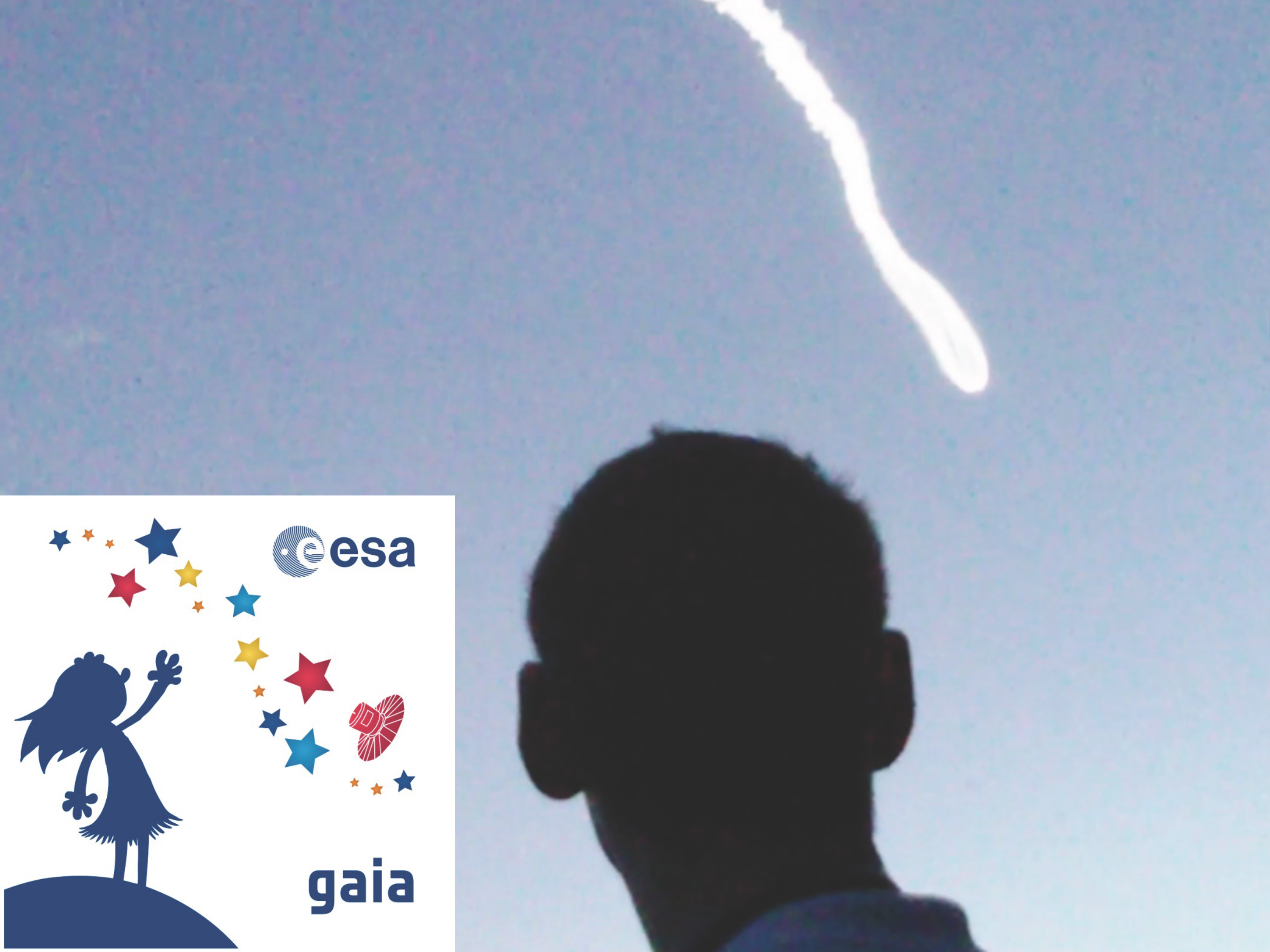 |
|
| "Gaia and me" - George Seabroke recreating the Gaia fairing logo at the launch | |
|
Two members of the Gaia team from the Mullard Space Science Laboratory (MSSL, part of University College London) travelled to South America on 18 December 2013 to watch the Gaia launch: me (George Seabroke, Gaia scientist in CU6) and Howard Huckle (Gaia software engineer in CU6), accompanied by his wife Lin. We met up with Leanne Guy (Gaia software engineer in CU7 based at the Geneva Observatory who also works with the team at MSSL) in Paris for our direct flight to Cayenne, the capital of French Guiana. After experiencing the strength of French Guianan rum (taken neat with lime and sugar), the Amazonian rainforest looked like broccoli from the plane with no sign of inhabitation until seeing the runway. The large photos of previous launches and collecting our luggage at the same time as the Gaia VIPs on a chartered flight all added to the sense of excitement. Landing only twelve hours before the launch at around 6pm local time, we got the hire car, drove to the hotel in downtown Cayenne and went to bed. 19 December 2013, launch day, 2am: alarm goes off, cue disorientation and tiredness! Hopefully this feeling was not shared by the attendees at the launcher fuelling authorisation meeting, which had started eight minutes previously. 2.12am (T-04:00:00): I had just about dragged myself out of bed for a cold shower when the launch vehicle fuelling began. 4.28am (T-01:45:00): end of fuelling operation and we have arrived at the Centre Space Guiana in Kourou after an hour's drive up the south Atlantic coast, while I was having my first breakfast of the day. 5.12am (T-01:00:00): mobile gantry withdrawal and we are still queuing outside with locals and Gaia colleagues from around Europe eagerly waiting to be let in to the Jupiter mission control centre (Figure 5). Coffee, croissants (second breakfast of the day) and TV screens of Gaia on the launch pad greeted us in a bar area. Seeing all the spotlights on the Soyuz with Gaia inside and steam swirling around got the goose bumps going – Gaia was really going to launch and we were here to witness it first hand! Next we were ushered into a seated auditorium with mission control (rows of people sitting at computers and large display screens) behind an enormous glass screen (Figure 2). We were told that doors on one side of the auditorium would open two minutes before launch to allow everyone to file out to the viewing gallery to see the launch. The large countdown clock ticked away as we watched live interviews and pre-prepared videos for the official launch TV coverage. |
|
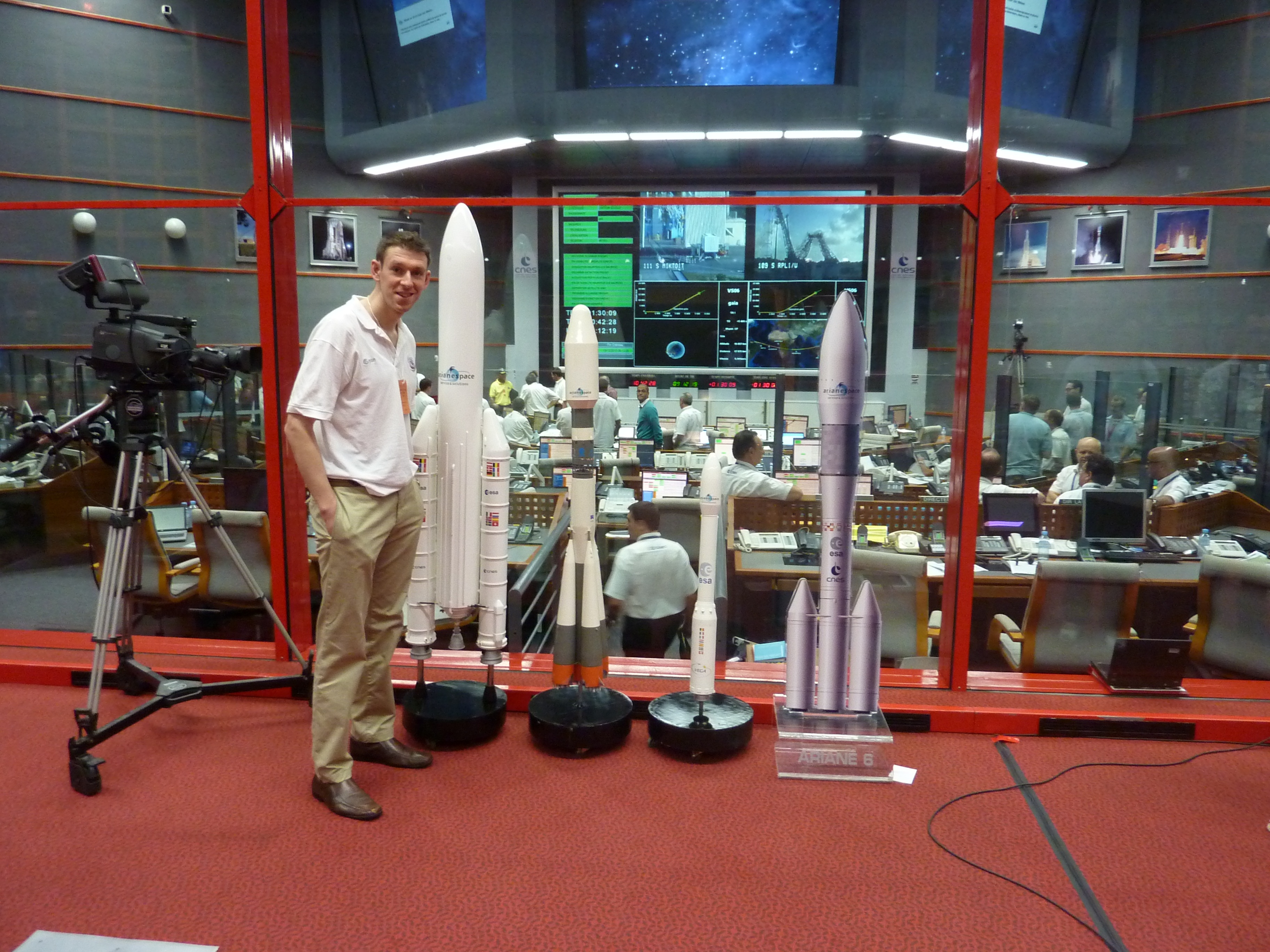 |
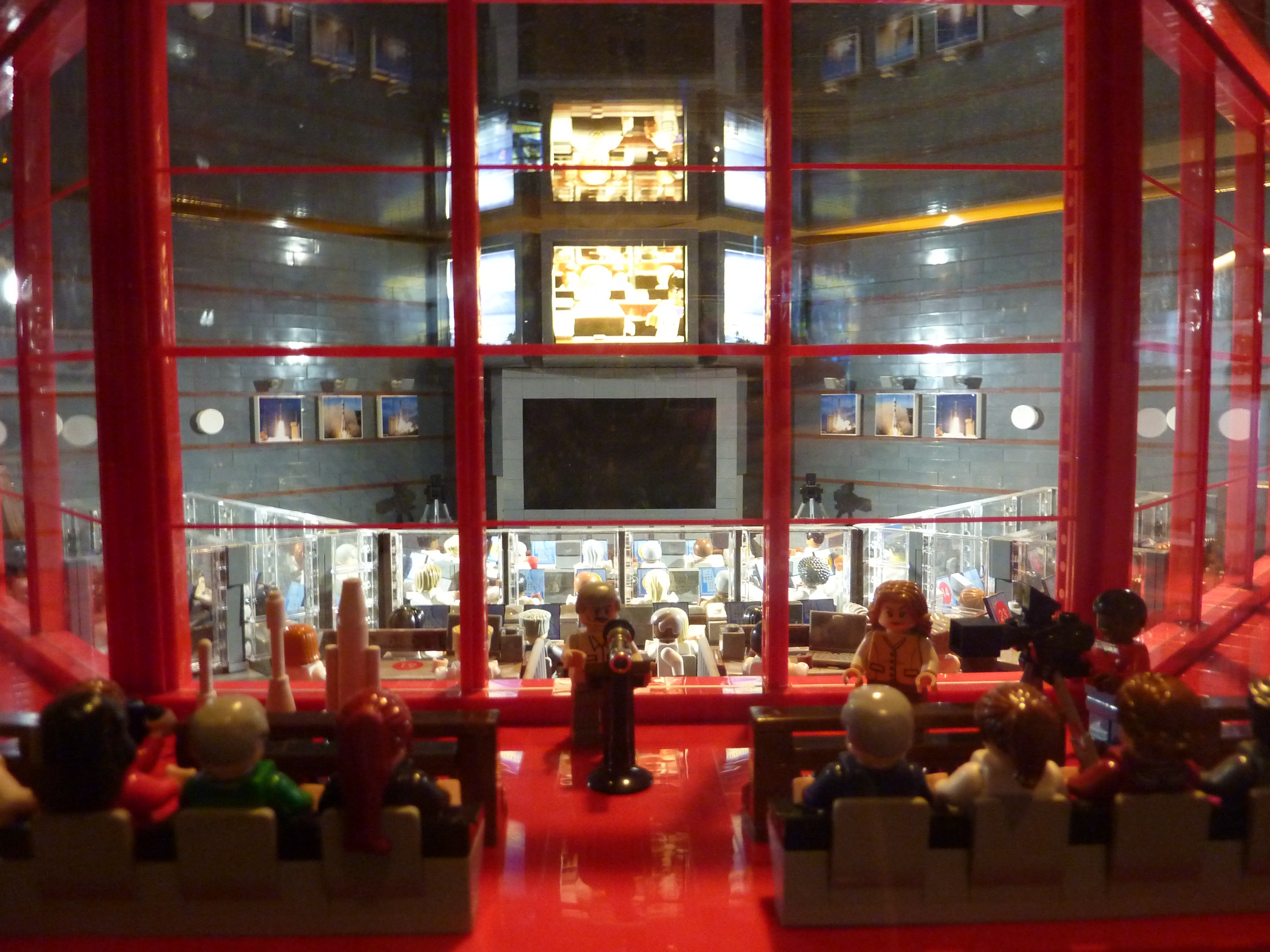 |
| 2) George Seabroke in the Jupiter mission control room | 3) Mission control room Lego-style in the Museé de l'Espace |
|
6.09am (T-00:02:25): on the TV screens we saw the upper composite umbilical drop off, 25 seconds to go before we were to be let out onto the viewing platform, the butterflies in my stomach are starting to flap their wings. We deliberately sat close to the doors so we could get out quickly to have a good view of the launch. T minus two minutes came and went and the doors did not open. They were being guarded by armed security men! We pointedly looked at them but they did not flinch. I started to wonder if we were going to be let out at all - maybe if we all rushed them, some of us would make it out? T minus one minute and the doors opened – phew! We all rushed out and peered expectantly into the night. You will see later why Leanne's movie of the launch is my favourite one. Although not evident to us at the time, three seconds into the movie (T-00:00:17), "we have ignition" of boosters (first stage) and central core (second stage) simultaneously. Our first sight of the launch is 17 seconds into the movie, when there is a red flash in the distance, which grows and then flashes again. We could hear the roar of the engines and the countdown in French being broadcast over the viewing platform, which is also captured by the movie: "Trois, deux, un, TOP, decolage" (liftoff). The red glow becomes yellow but Gaia was still not yet visible. Ten seconds later and a golden ball climbs into view. |
|
| Movie of the Gaia launch | |
|
Remarkably round in appearance, the ball climbed vertically and was momentarily completely obscured by a cloud. The light beautifully illuminated the cloud before it reappeared. While still in the cloud, 30 seconds after the launch, we heard a gentle rumble of sound. This was the actual noise of the engines reaching us after travelling the 10 km between the launch site and our viewing platform! Gaia's trajectory started to arc towards us, climbing majestically against the beautiful gradient of blues across the sky, from navy to light blue towards the Sun, which was still below the horizon. Towards its apex, the golden ball becomes red around its edge, temporary leaves behind a contrail and then elongates. After the apex, one can still make out the ball but the rocket exhaust elongates its shape more and more. It actually looks as though Gaia is heading back towards the ground! (It was actually heading away from us then.) The contrail reappears and shortly afterwards at T+00:01:58 (2min19sec into the movie) you can see the first stage boosters being jettisoned as a bulge in the contrail and an "ooh" from the crowd. 10 seconds later you can see four points of light twinkling near the contrail. These lights are the exhaust flames of the four boosters tumbling in and out of our line of sight. Then in the movie you can hear Leanne calling to me. At the time I was thinking "What do you want? I'm trying to watch the launch!" I am now very grateful she got my attention because she filmed my silhouette with Gaia in the background. The still image from it (Figure 1) shows Gaia and me together (for the first and last time), recreating the logo on the aerodynamic fairing that protected Gaia during its flight through the atmosphere. Not visible to us, 15 seconds after the movie finishes (T+00:03:40), this fairing was jettisoned because it was no longer needed when Gaia was above the atmosphere. Gaia had reached space with its sun shield still folded up around it. The movie shows the exhaust plumes starting to billow out as the atmosphere gets thinner over 100 km up. The maximum billowing occurred after the end of the movie. It was a spectacular sight (see Figure 4) and drew a chorus of wows from the crowd. The central core (second stage) has a RD-108A engine with four combustion chambers, each with a nozzle. It also has four vernier thrusters, used for three-axis flight control once the boosters have separated. This suggests there should be eight plumes in Figure 4 but the viewing angle makes it difficult to delineate them all. |
|
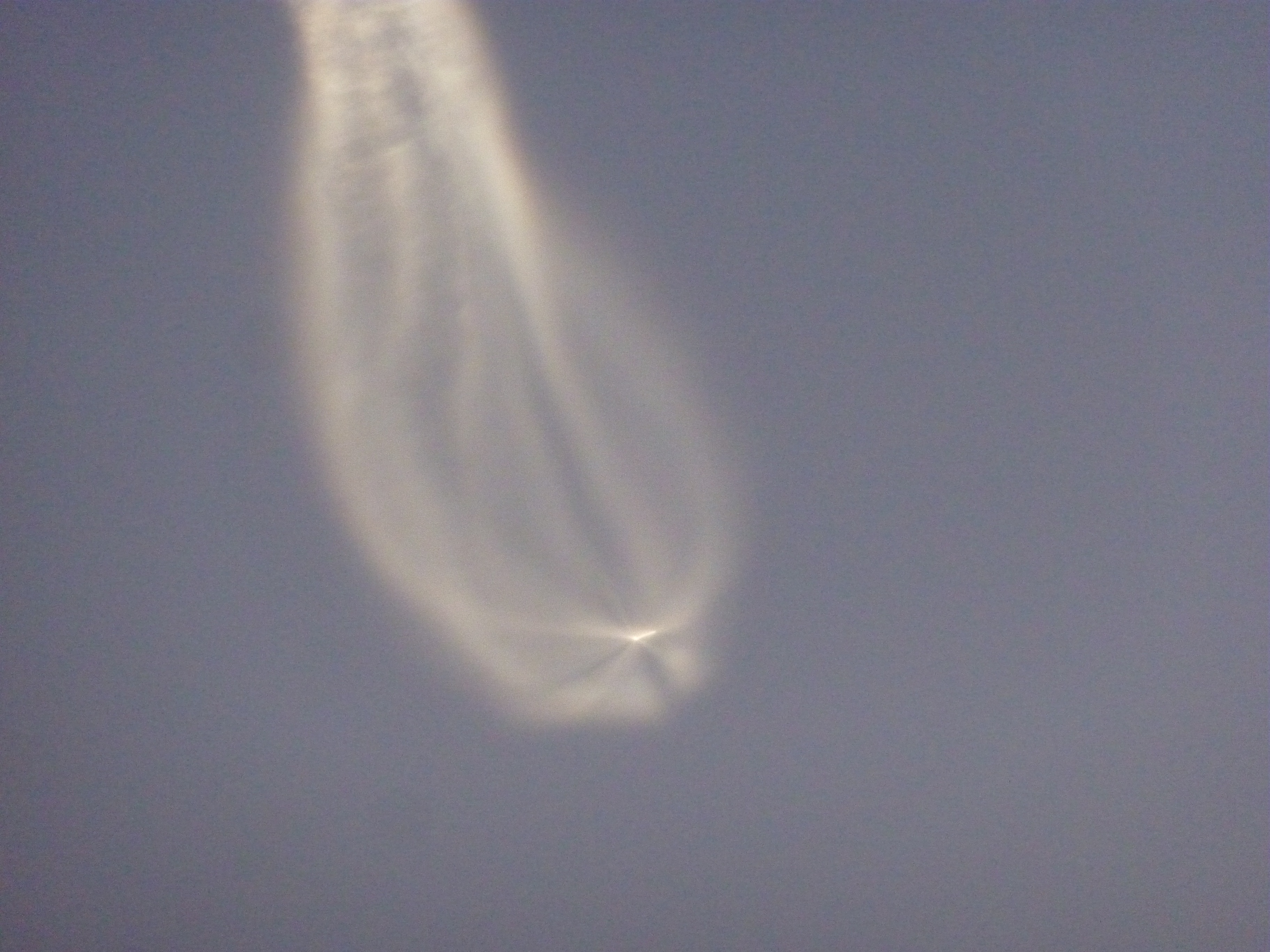 |
|
| 4) Exhaust plume from the Soyuz central core engine. When this photo was taken, Gaia was in space (over 100 km in altitude and still climbing), over 300 km in distance over the South Atlantic and travelling at around 3km/s (10,000 km/hour) | |
|
The billowing ceased when the central core (second stage) engine shut down and separated from the third stage (T+00:04:48). Then Gaia was just a point of yellow light, until it disappeared into the dawn.
I did not feel overly emotional as it finally disappeared from view because I was waving goodbye to something that I did not help build, had never seen and so did not know very well. Even though I saw the launch with my own eyes, it is strange to think that I have never seen the Gaia satellite. I did not even see the main rocket because the glare of the exhaust fumes was too great, even through binoculars. I may have seen some of the CCDs that are on Gaia both in Chelmsford, where all the Gaia CCDs were made by e2v, and at MSSL, where all the CCDs and associated electronics were tested. However, not all the CCDs made were selected to go on the satellite and I do not know which CCDs I saw. In the last four years, I have got to know the data that Gaia's Radial Velocity Spectrometer (RVS) is sending back by helping to design and test the on-ground RVS data processing pipeline. My job during commissioning was to get to know what the real RVS data is like. There were some major surprises but that is another story (described here). My job for the foreseeable future is to continue to get to know the RVS data. This could be for the next decade, by which time I should know Gaia very well and it really will be emotional at the final end-of-mission goodbye. We were ushered back into the control room by the guards and many people went back outside for the launch breakfast with champagne. There were still important mission stages to get through so I stayed in the control room watching the screens and the reactions of the mission controllers. First there was the separation of the third stage (T+00:09:23), in preparation for the Fregat burns. The first one (T+00:10:23) put Gaia and the Fregat into an intermediate orbit (Fregat shutdown and beginning of ballistic phase T+00:12:39). The second one (T+00:21:25) put Gaia and the Fregat into the targeted orbit for Gaia around the Earth (Fregat shutdown and beginning of ballistic phase T+00:36:59). When Gaia separated from the Fregat (T+00:41:59), the Arianespace "rocket scientists" clapped, cheered, stood up and shook hands. Their job was done: they had successfully launched Gaia and handed control over to the European Space Operations Centre in Darmtstadt, Germany, and so many of them left the control room. Gaia was now on its own and under its own propulsion going round the Earth. More people went downstairs but I remembered there was one last critical step before we could relax and celebrate: the deployment of the sunshield. The clapping, cheering and hand shaking amongst the astronomers in the control room around 90 minutes after launch let us know it had been successful and we could relax! By the time I got outside, the launch party was in full swing. It was now around 7am and already hot, we had been up for 5 hours, witnessed history so it was time to celebrate with champagne and the third breakfast of the day! Astronomy is not exactly rocket science, except on launch day, when it is! It was a privilege to witness the serene beauty of the launch and be there at the start of the Gaia mission. |
|
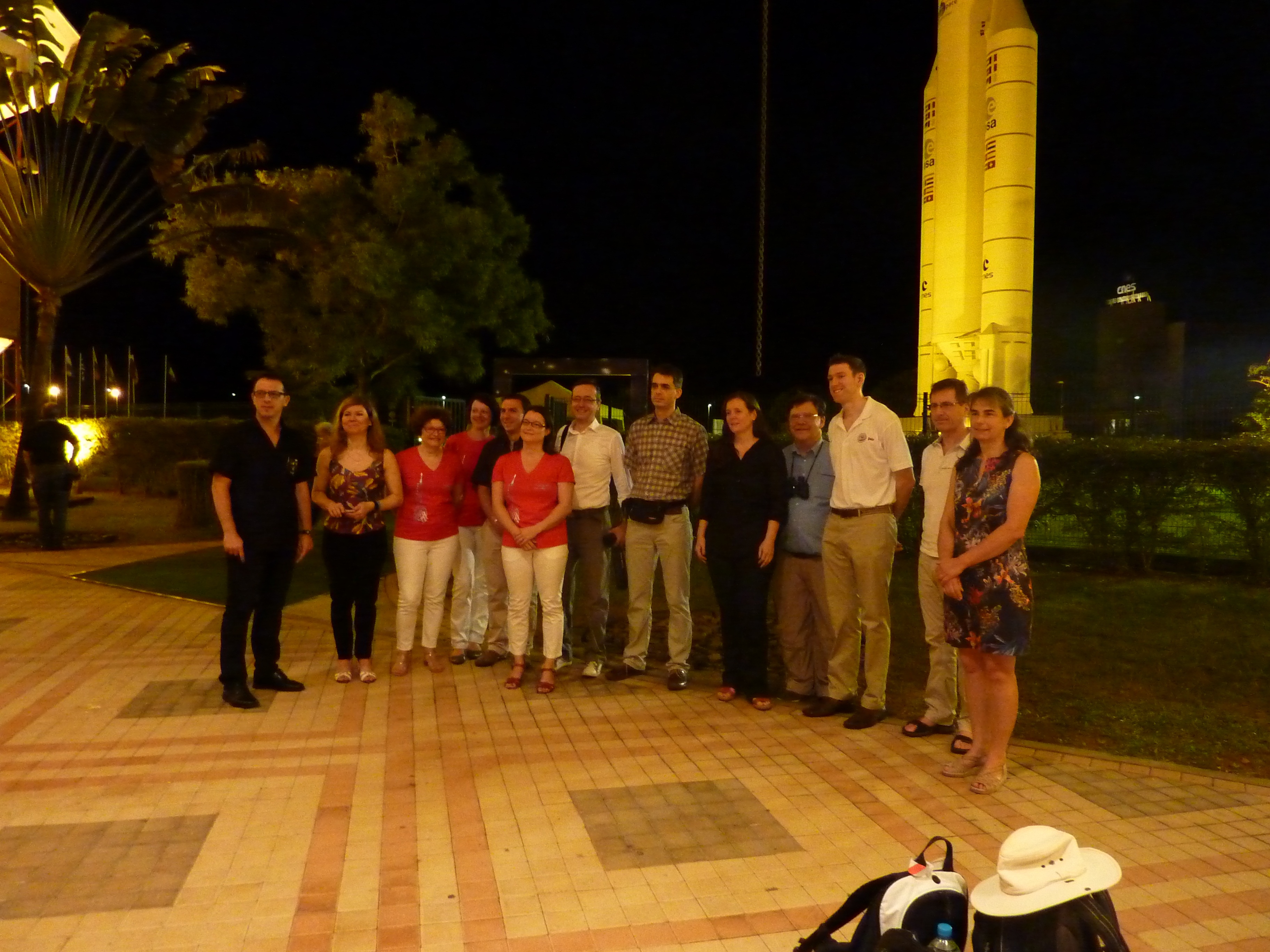 |
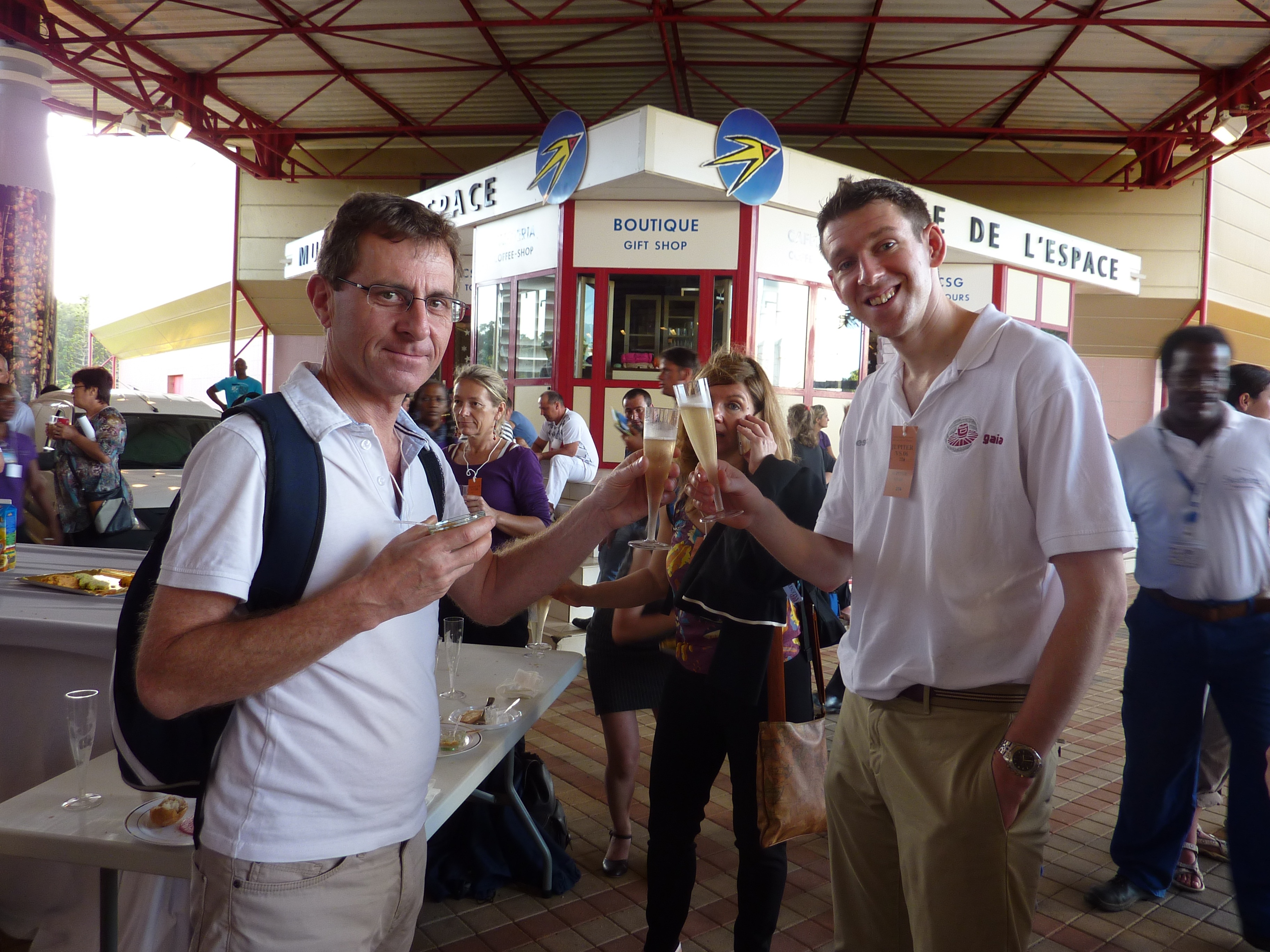 |
| 5) Nervous Gaia colleagues before launch (from left to right): Kader Amsif, Antonella Vallenari, Veronique Valette, Chantal Panem, Benoit Frezouls, Laurence Chaoul, Paolo Tanga, Coryn Bailer-Jones, Leanne Guy, Howard Huckle, George Seabroke, Frederic Thevenin and Caroline Soubiran | 6) Relaxed Gaia colleagues after launch (from left to right): Frederic Thevenin, Antonella Vallenari and George Seabroke celebrating |
| Image credits | |
|
Figure 1: image from movie courtesy of Leanne Guy, Gaia fairing logo courtesy of ESA, composition by George Seabroke Figure 2, 3, 4,5, 6: George Seabroke video: courtesy of Leanne Guy |
|

